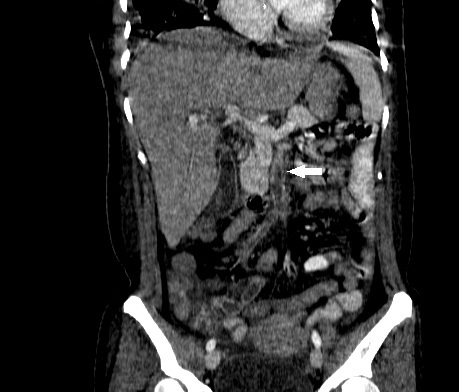Case Presentation:
We present a case of 37y.o. woman, a previously healthy visiting scholar from China, who presented with nausea, vomiting, diarrhea and vague diffuse abdominal discomfort . Her initial laboratory results were essentially normal. Emergency room evaluation concluded viral gastroenteritis and she was released home. She returned 4 days later complaining of fever and poor appetit, associated with minimal abdominal symptoms. Her laboratory findings were notable for severe and acute thrombocytopenia ( Plt: 38, normal WBC and Hgb, abnormal LFT’s with AST: 89 ALT: 155, ALP: 321, T. bili: 2.6. ) . RUQ U/S described a small hemangioma but otherwise normal findings. CXR had lower lobe opacification. For suspected atypical pneumonia Ceftriaxone and Azithromycin was initiated.
Subsequent positive blood culture with Bacteroides fragillis prompted an abdominal and pelvic CT diagnostic for perforated appendicitis with small abscess ( 1.9×1.4 cm), extensive superior mesenteric vein thrombosis and septic emboli in the right hepatic lobe. She had complete recovery with non surgical management with IV Ertapenem x 4 weeks and anticoagulation with Heparin bridged to Coumadin x 3 month, with the plan for interval appendectomy when anticoagulation is completed.
Discussion:
Pylephlebitis ( infective suppurative thrombosis of the portal vein or its tributaries, the superior mesenteric vein and splenic veins) is a rare and potentially lethal complication, and is associated with intraperitoneal infectious or inflammatory conditions like diverticulitis, appendicitis, pancreatitis, cholangitis and inflamatory bowel disease. The diagnosis is difficult , the clinical findings are vague (such as : fever, malaise, non specific epigastric and right upper quadrant pain, nausea, diarrhea) with non specific laboratory results ( such as : leukocytosis and mildly abnormal LFT’s). Pylephlebitis is associated with bacteremia in up to 50% of cases and Bacteroides fragilis is the most commonly identified organism, following by E coli and Streptococcus spp.
Conclusions:
Pylephlebitis is a challenging diagnosis and require high index of suspicion. Bacteroides fragilis bacteremia of unknown etiology should prompt investigation for intra-abdominal source, like pylephlebitis or perforated appendicitis. For selected cases of appendicitis complicated with pylephlebitis, intravenous antibiotic and anticoagulaiton is an acceptable alternative therapy to emergent appendectomy.
